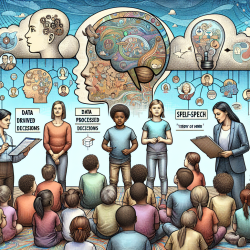Introduction
In the realm of speech-language pathology, understanding the nuances of mentalization in various contexts can enhance therapeutic outcomes. A recent study titled Attribution of Mental States in Glossolalia: A Direct Comparison With Schizophrenia offers insights into the mentalization processes in glossolalists compared to individuals with schizophrenia. This blog aims to distill the key findings of this study and discuss their implications for practitioners working with children in online therapy settings.
Key Findings
The study utilized the Animated Triangle Test (ATT) and the Reading the Mind in the Eyes Test (RMET) to assess mentalization. The findings revealed that glossolalists exhibited a generalized hypermentalization, attributing mental states even to random movements. In contrast, individuals with schizophrenia displayed both hypo- and hypermentalization, with a tendency to misinterpret random movements as intentional while struggling with intentional interactions.
Implications for Practitioners
Understanding these mentalization patterns can be particularly beneficial for practitioners in several ways:
- Enhanced Assessment: Utilizing tools like ATT and RMET can aid in identifying specific mentalization patterns in children, allowing for more tailored interventions.
- Targeted Interventions: Recognizing hypermentalization in glossolalists can guide practitioners to develop strategies that harness this heightened sensitivity in social cognition, potentially improving social skills and emotional understanding.
- Distinguishing Conditions: Differentiating between hypermentalization in glossolalia and the maladaptive patterns seen in schizophrenia can prevent misdiagnosis and ensure appropriate therapeutic approaches.
Encouraging Further Research
The study highlights the need for further research into the relationship between mentalization and various cultural and religious contexts. Practitioners are encouraged to contribute to this growing body of knowledge by conducting studies that explore mentalization in diverse populations, particularly in children.
Conclusion
The findings from this study underscore the importance of understanding mentalization processes in different contexts. By incorporating these insights into practice, speech-language pathologists can enhance their therapeutic approaches, ultimately leading to better outcomes for children. For those interested in delving deeper into the research, the original paper can be accessed here: Attribution of Mental States in Glossolalia: A Direct Comparison With Schizophrenia.










